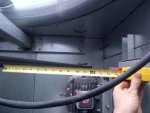aaronbailey52
Member
Looking for some input on the working clearance requirements about a safety switch/disconnect. Situation is a 7.5 hP motor inside of a cooling tower enclosure. There is a disconnect adjacent to this motor, inside of the enclosure. The fan belt from the motor is at the same height as the handle of the disconnect and at its farthest point is 15" away.
Now, the motor is controlled by a VFD with lockable disconnect. So, circuit breaker feeds VFD. VFD feeds disconnect switch. Disconnect feeds motor.
Is it reasonable to consider that the disconnect is unlikely to be operated or adjusted when energized, considering that power can be locked out at the VFD? Cooling tower is within sight of the VFD at about 10' away.
I would also note that the install instructions for the cooling tower call for the disconnect on the outside of the enlosure.
The disconnect does in no way, shape, or form meet working space requirements, if it is considered to require examining while energized.
Thanks
Now, the motor is controlled by a VFD with lockable disconnect. So, circuit breaker feeds VFD. VFD feeds disconnect switch. Disconnect feeds motor.
Is it reasonable to consider that the disconnect is unlikely to be operated or adjusted when energized, considering that power can be locked out at the VFD? Cooling tower is within sight of the VFD at about 10' away.
I would also note that the install instructions for the cooling tower call for the disconnect on the outside of the enlosure.
The disconnect does in no way, shape, or form meet working space requirements, if it is considered to require examining while energized.
Thanks



